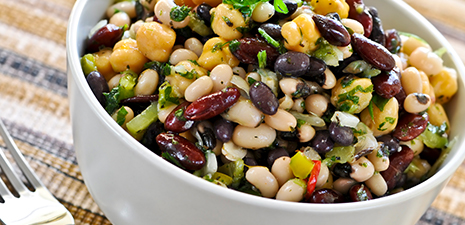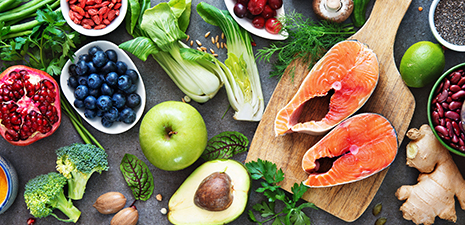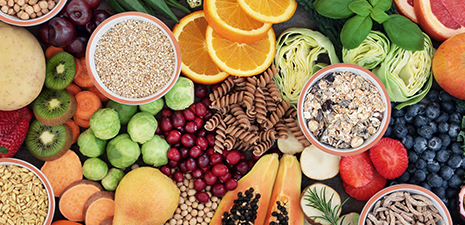Outsmart hunger with nutrient-dense foods that contain more fiber, healthy fats, and protein. A few simple additions or swaps can help you feel fuller and more satisfied.

10 Foods That Help You Feel Fuller Longer
Hunger is a way that the body signals to us that it needs energy and nutrients. Conveniently, the foods that best satisfy hunger are those that are nutrient-dense as well. Talk about a one-two nutritional punch! The best way to satisfy hunger and increase fullness is to include foods high in filling macronutrients in each meal and snack.
Food Components That Satisfy Your Appetite
When choosing foods that help you feel fuller longer, the key factors to look for are foods that are good sources of:
- Protein: Protein is the most satiating macronutrient. It actually changes the levels of several satiety hormones, including the hunger hormone ghrelin and peptide YY, a hormone that makes you feel full.1 Not only does eating more protein-rich foods keep us fuller, it also helps us burn more calories.
- Fiber: Fiber takes longer to pass through the digestive system. Adding more high-fiber foods to our diet can help us feel fuller longer, which may help us avoid overeating at our next meal. For a food to be classified as high-fiber, it should have at least 3–5 grams of fiber per serving.2
- Healthy fats: Healthy fats like omega-3 fatty acids and plant-based monounsaturated oils are necessary for good health. It seems that fats have an effect on satiety and appear to regulate appetite through the release of appetite hormones and by slowing down the rate at which your stomach empties during digestion.3
These food components take longer to digest than, say, foods that are mainly made up of simple carbohydrates. In fact, it seems that the more “whole” a food is—that is, unprocessed, unrefined, and free of additives—the more filling it tends to be.
Foods That Help Beat Hunger and Keep You Fuller Longer
Here are 10 examples of whole, nutrient-dense foods that not only will help keep you satisfied, but are great for overall health as well.
1. Whole Grains
Whole grains, such as brown rice, whole wheat bread, and whole wheat pasta, are linked to weight control and maintaining a healthy weight.4 This could be due to the fiber, nutrients, and plant compounds found in whole grains. They can increase the feeling of satiety and help you consume fewer calories at a time. Whole grains are also good for our overall health, and tend to help achieve a healthy weight more consistently than refined grains. The 2015-2020 Dietary Guidelines for Americans recommends that at least half of your daily grain intake be whole grains.5
2. Greek Yogurt
I like to recommend Greek yogurt over regular yogurt since it’s much higher in protein and therefore keeps you fuller for longer. It’s important to try to choose varieties that are low in added sugars. Adding fruit such as peaches or strawberries will provide the necessary sweetness, with the added benefits of vitamins, minerals, antioxidants, and fiber. Toppings like low-sugar granola or nuts can also provide some added fiber, as well as well as punching up the satiety factor.
3. Avocado
Avocados are a nutrient-dense food. They’re high in heart-healthy fats, and a good source of fiber (3 grams per 1⁄3 avocado, which is the recommended serving size).6 The healthy fats in avocado also help satisfy your appetite longer, and it doesn’t hurt that they taste delicious!
4. Oatmeal
Oats are fairly low in calories and a great source of soluble fiber, which has the ability to soak up water, helping you feel fuller. Oatmeal may also help release satiety hormones and delay the emptying of the stomach.7 Try to choose plain, unflavored varieties in order to avoid excessive added sugars. You can top oatmeal off with fruit or nuts to make them more satisfying and boost their nutrient content.
5. Red Chili Pepper
Capsaicin is a component of red chili peppers that give them their pungent taste. There’s evidence that capsaicin increases the sensation of fullness and decreases the desire to eat.8 Red chili pepper can be ingested orally or in capsule form—however, the decrease in food intake seems to be more significant when red chili pepper is ingested orally. Try sprinkling some in your salads, stews, soups, and sandwiches.
6. Fish
Fish is a lean, healthy, filling protein source. The American Heart Association and the Dietary Guidelines 2015-2020 recommend at least two servings of fish per week, especially high-fat fish. One serving is equivalent to 3.5 ounces or 3⁄4 cup of flaked fish. Fish not only provides us with bioavailable protein, but is a great source of omega-3 fatty acids. These healthy fats are great for heart protection and for lowering inflammation in the body. The fish with the highest omega-3 content are salmon, mackerel, herring, lake trout, sardines, and albacore tuna.9
7. Nuts
Nuts are a great snack option to help tide you over between meals. They’re good sources of all three satiety boosters: protein, fiber and healthy fats. In fact, one study found that mixed nuts promote satiety in overweight and obese adults while maintaining stable blood glucose and insulin levels.10 They also have vitamins, minerals, and antioxidants that help promote overall health. Try to choose unsalted and unsweetened nuts to reap the most health benefits.
8. Beans and Legumes
Legumes are an excellent source of plant-based protein as well as fiber. 1⁄2 cup provides 7 grams of protein, which together with its fiber content (6 grams), makes for a satisfying, filling food.11 They also promote the feeling of satiety, which in the long run helps to maintain a healthy weight. Consuming beans regularly benefits our health in many ways. Try them in salads, sandwiches, soups, stews, or pureed into dips.
9. Eggs
Eggs are a great source of high-quality protein, which can make for a filling food, as well as vitamins, minerals, and carotenoid antioxidants (which help protect our eye health). A large egg contains around 6 grams of protein, including all nine essential amino acids.12 In fact, research has shown that including eggs more frequently in our diets can promote greater satiety and significantly reduce short-term food intake.13 One study suggests that consumption of eggs for breakfast results in less variation of plasma glucose and insulin, a suppressed ghrelin response, and reduced energy intake.14 Try adding vegetables to a yummy egg omelet (such as spinach, mushrooms, and broccoli) to further help increase satiety, and overall daily vegetable intake as well.
10. Fruits and Vegetables
Fruits and vegetables are full of vitamins, minerals, and phytonutrients. They’re also high in fiber and water, which helps fill you up, yet they’re low in calories. One study found that eating vegetables high in inulin (a type of fermentable dietary fiber that can improve “good” gut bacteria and provide health benefits) showed greater satiety, and a reduced desire to eat sweet, salty, and fatty food.15 Yet another reason to include more veggies in your diet. Aim for 5–9 servings a day.16 Don’t really like the taste? Try them in smoothies for a refreshing, delicious way to beat hunger and fuel up your body!
So, there you have it. By including more nutritionally dense, filling food you not only kick hunger to the curb and maintain a healthy weight, but you’re also improving your health and taking optimal care of your body.
Rx Only. For the safe and proper use of Plenity or more information, talk to a healthcare professional, read the Patient Instructions for Use.
- Lejeune MP, Westerterp KR, Adam TC, Luscombe-Marsh ND, Westerterp-Plantenga MS. Ghrelin and glucagon-like peptide 1 concentrations, 24-h satiety, and energy and substrate metabolism during a high-protein diet and measured in a respiration chamber. Am J Clin Nutr. 2006;83(1):89–94. doi:10.1093/ajcn/83.1.89 https://pubmed.ncbi.nlm.nih.gov/16400055/
-
Slavin JL. Position of the American Dietetic Association: health implications of dietary fiber [published correction appears in J Am Diet Assoc. 2009 Feb;109(2):350]. J Am Diet Assoc. 2008;108(10):1716–1731. doi:10.1016/j.jada.2008.08.007
https://pubmed.ncbi.nlm.nih.gov/18953766/ -
Samra RA. Fats and Satiety. In: Montmayeur JP, le Coutre J, editors. Fat Detection: Taste, Texture, and Post Ingestive Effects. Boca Raton (FL): CRC Press/Taylor & Francis; 2010.
https://pubmed.ncbi.nlm.nih.gov/21452472/ -
Roberts, S. B., Karl, J. P., Meydani, M., Junaidah B. B., Vanegas, S. M., Goldin, B., Kane, A., Rasmussen, H., Saltzman, E., Vangay, P., Knights, D., Chen, C-Y. O., Das, S.K., Jonnalagadda, S.S., Meydani, S.N.. (2017, Month #). Substituting whole grains for refined grains in 6-week randomized trial favorably affects energy balance parameters in healthy men and post-menopausal women. American Journal of Clinical Nutrition. Advance online publication. DOI: 10.3945/ajcn.116.139683
https://pubmed.ncbi.nlm.nih.gov/28179223/ - https://health.gov/sites/default/files/2019-09/2015-2020_Dietary_Guidelines.pdf
- https://loveonetoday.com/nutrition/avocado-nutrition-facts-label/
-
Beck EJ, Tapsell LC, Batterham MJ, Tosh SM, Huang XF. Increases in peptide Y-Y levels following oat beta-glucan ingestion are dose-dependent in overweight adults. Nutr Res. 2009;29(10):705–709. doi:10.1016/j.nutres.2009.09.012
https://pubmed.ncbi.nlm.nih.gov/19917449/ -
Janssens PL, Hursel R, Westerterp-Plantenga MS. Capsaicin increases sensation of fullness in energy balance, and decreases desire to eat after dinner in negative energy balance. Appetite. 2014;77:44–49. doi:10.1016/j.appet.2014.02.018
https://pubmed.ncbi.nlm.nih.gov/24630935/ - https://www.heart.org/en/healthy-living/healthy-eating/eat-smart/fats/fish-and-omega-3-fatty-acidss
- Godwin N, Roberts T, Hooshmand S, Kern M, Hong MY. Mixed Nuts May Promote Satiety While Maintaining Stable Blood Glucose and Insulin in Healthy, Obese, and Overweight Adults in a Two-Arm Randomized Controlled Trial. J Med Food. 2019;22(4):427–432. doi:10.1089/jmf.2018.0127 https://pubmed.ncbi.nlm.nih.gov/30897012/
- https://fdc.nal.usda.gov/fdc-app.html#/food-details/868244/nutrients
- https://fdc.nal.usda.gov/fdc-app.html#/food-details/577532/nutrients
- Vander Wal JS, Marth JM, Khosla P, Jen KL, Dhurandhar NV. Short-term effect of eggs on satiety in overweight and obese subjects. J Am Coll Nutr. 2005;24(6):510–515. doi:10.1080/07315724.2005.10719497 https://pubmed.ncbi.nlm.nih.gov/16373948
- Ratliff J, Leite JO, de Ogburn R, Puglisi MJ, VanHeest J, Fernandez ML. Consuming eggs for breakfast influences plasma glucose and ghrelin, while reducing energy intake during the next 24 hours in adult men. Nutr Res. 2010;30(2):96–103. doi:10.1016/j.nutres.2010.01.002 https://pubmed.ncbi.nlm.nih.gov/20226994/
-
Hiel S, Bindels LB, Pachikian BD, et al. Effects of a diet based on inulin-rich vegetables on gut health and nutritional behavior in healthy humans. Am J Clin Nutr. 2019;109(6):1683–1695. doi:10.1093/ajcn/nqz001
https://pubmed.ncbi.nlm.nih.gov/31108510/ - https://www.dietaryguidelines.gov/sites/default/files/2019-05/2015-2020_Dietary_Guidelines.pdf





